Text
UNBLENDING CELTIC POLYTHEISTIC PRACTICES
Celtic Umbrella
This lesson is largely focusing on the insular Celtic nations & Brittany (Ireland/Eire, Scotland/Alba, Wales/Cymru, Cornwall/Kernow, Isle of Man/Mannin, & Brittany/Breizh) - traditionally regarded as 6 out of the 7 Celtic nations. Galicia/Galizia is the 7th, but because of a mix of the below + my own lack of knowledge, I won't be covering them.
The vast swath of Continental Celtic cultures are a different but equally complex topic thanks to extinction, revival, varying archaeological artefacts and the work of modern practioners to piece unknown parts back together.
This will serve as a quick 'n' dirty guide to the insular Celtic nations, Celtic as a label, blood percentages and ancestry, the whats and whys of "Celtic soup", and how to unblend practice.
The insular Celtic groups are split into two language groups: Brythonic languages and Gaelic languages.
Brythonic languages are Cymraeg/Welsh, Kernewek/Cornish, & Breton
Gaelic languages are Gàidhlig/Scottish, Gaeilge/Irish, & Gaelg/Manx.
The language split leads to certain folkloric and religious figures & elements being more common within the language group than without. All of these nations had historic cultural exchange and trade routes via the Celtic sea (and beyond). Despite this, it is still important to respect each as a home to distinct mythologies.
Pros/Cons of a broad Celtic umbrella
Pros
- Used within celtic nations to build solidarity - Relates to a set of cultures that have historic cultural exchange & broad shared experiences - A historic group category - Celtic nations’ culture is often protected under broad legislation that explicitly highlights its ‘Celtic-ness’.
Cons
- Can be used reductively (in academia & layman uses) - Often gives in to the dual threat of romanticisation/fetishisation & erasure - Conflates a lot of disparate practices under one banner - Can lead to centring ‘celtic american’ experiences. - Celtic as a broad ancestral category (along with associated symbols) has also been co-opted by white supremacist organisations.
In this I’m using ‘Celtic’ as a broad umbrella for the multiple pantheons! This isn’t ideal for specifics, but it is the fastest way to refer to the various pantheons of deities that’ll be referenced within this Q&A (& something that I use as a self identifier alongside Cornish).
What about blood % or ancestry?
A blood percentage or claimed Celtic ancestry is NOT a requirement to be a follower of any of the Celtic pantheons. The assumption that it does or is needed to disclose can feed easily into white supremacist narratives and rhetoric, along side the insidious implications that a white person in the USA with (perceived or real) Celtic ancestry is 'more celtic' than a person of colour living in a Celtic region (along with other romanticised notions of homogenously white cultures).
Along side this, a blood percentage or distant ancestry does not impart the culture and values of the Celtic region or it's recorded pagan practices by itself. Folk traditions are often passed down within families, but blood percentage is not a primary factor within this.
Connecting with ancestry is fine, good, and can be a fulfilling experience. It stops being beneficial when it leads to speaking over people with lived experiences & centres the USA-based published and authors - which can lead to blending/souping for reasons further on.
What is 'soup'?
Celtic soup is a semi-playful term coined by several polytheists (primarily aigeannagusacair on wordpress) to describe the phenomenon of conflating & combining all the separate pantheons and practices from the (mainly) insular Celtic nations into one singular practice - removing a lot of the regionalised folklore, associated mythos, & varying nuances of the nations that make up the soup.
Why does it happen?
The quick version of this is book trends and publishing meeting romanticisation and exotification of Celtic cultures (especially when mixed with pre-lapsarian views of the Nations). It's miles easier to sell a very generally titled book with a lot of Ireland and a little of everywhere else than it is to write, source and publish a separate book on each.
This is where centering American publishers and authors becomes an issue - the popular trend of USA-based pagan publications to conflate all celtic nations makes it hard to find information on, for example, Mannin practices because of the USA’s tendency to dominate media. Think of Llewellyn’s “Celtic Wisdom” series of books.
It has also been furthered by 'quick research guides'/TL;DR style posts based on the above (which have gained particular momentum on tumblr).
The things that have hindered the process in unblending/"de souping" is the difficulty in preserving independently published pamphlets/books from various nations (often more regionalised and immediately local than large, sweeping books generalising multiple practices) along with the difficulty of accessing historic resources via academic gatekeeping.
All of this has lead to a lack of awareness of the fact there is no, one, singular Celtic religion, practice or pantheon.
Why should I de-soup or unblend my practice?
Respecting the deities
It is, by and large, considered the bare minimum to understand and research a deity's origin and roots. The conflation of all insular Celtic deities under one singular unified pantheon can divorce them from their original cultures and contexts - the direct opposite to understanding and researching.
Folklore and myth surrounding various Celtic deities can be highly regionalised both in grounded reality and geomythically - these aren't interchangeable locations and are often highly symbolic within each nation.
Brú na Bóinne, an ancient burial mound in Ireland, as an entrance to the otherworld of the Tuatha Dé Danann.
Carn Kenidjack & the Gump as a central site of Cornish folk entities feasts and parties, including Christianised elements of Bucca’s mythology.
The Mabinogion includes specific locations in Wales as well as broad Kingdoms - it’s implied that Annwn is somewhere within the historic kingdom of Dyfed, & two otherworldly feasts take place in Harlech & Ynys Gwales.
Conflating all celtic pantheons under one banner often leads to the prioritisation of the Irish pantheon, meaning all of the less ‘popular’ or recorded deities are sidelined and often left unresearched (which can lead to sources & resources falling into obscurity and becoming difficult to access).
Respecting the deities
Deities, spirits, entities, myth & folklore are often culturally significant both historically and to modern day people (just average folks along with practitoners/pagans/polytheists and organisations) located in the various Nations
A primary example is the initiatory Bardic orders of Wales and Cornwall.
Desouping/Unblending makes folklorist's lives easier as well as casual research less difficult to parse. The general books are a helpful jumping off point but when they constitute the bulk of writing on various Celtic polytheisms, they become a hinderance and a harm in the research process.
A lot of mythology outside of deities & polytheisms is also a victim of ‘souping' and is equally as culturally significant - Arthurian mythology is a feature of both Welsh and Cornish culture but is often applied liberally as an English mythology & and English figure.
Celtic nations being blended into one homogenous group is an easy way to erase cultural differences and remove agency from the people living in celtic nations. Cornwall is already considered by a large majority of people to be just an English county, and many areas of Wales are being renamed in English for the ease of English tourists.
How can I de-soup?
Chase down your sources' sources, and look for even more sources
Check your sources critically. Do they conflate all pantheons as one? Do they apply a collective label (the celts/celts/celt/celtic people) to modern day Celtic nations? How far back in history do they claim to reach?
Research the author, are they dubious in more ways than one? Have they written blog articles you can access to understand more of their viewpoints? Where are they located?
Find the people the author cites within their work - it can be time consuming but incredibly rewarding and can also give a good hint at the author's biases and research depth. You may even find useful further reading!
Find primary sources (or as close too), or translations of the originating folklore, e.g The Mabinogion. Going to the source of a pantheon’s mythos and folklore can be helpful in discerning where soup begins in more recent books as well as gaining insight into deities' actions and relationships.
Ask lots of questions
Question every source! Question every person telling you things that don't define what pantheon or region they’re talking about! Write all your questions down and search for answers! Talk to other polytheists that follow specific Celtic pantheons, find where your practices naturally overlap and where they have been forced into one practice by authors!
Be honest with yourself
There’s no foul in spreading your worship over several pantheons that fall under the celtic umbrella! A lot of polytheists worship multiple pantheons! But be aware of the potential for soup, and make sure you’re not exclusively reading and working from/with sources that conflate all practices as one.
If you approach any Celtic polytheistic path with the attitude of blood percentage or 'ancestral right', stop and think critically about why you want to follow a Celtic polytheistic path. Is it because it's the most obviously 'open' path to follow? Is it a desire to experience what other folks experience? Being critical, turning inward, and really looking at yourself is important. Originally posted in the Raven's Keep discord server
505 notes
·
View notes
Text
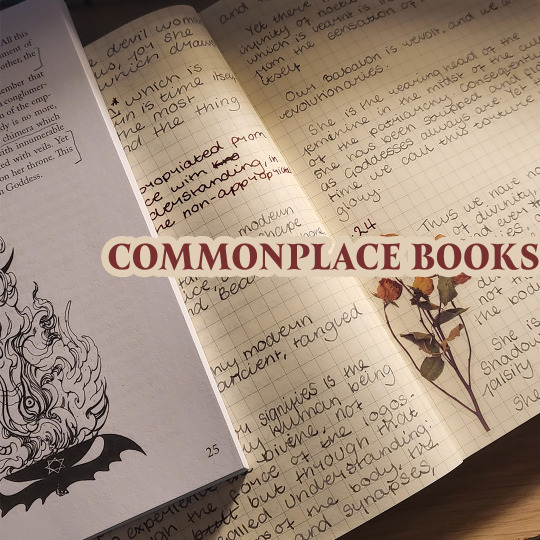
What is a commonplace book
Commonplace books are a method of compiling knowledge into one place, traditionally by handwriting but more recently with computers/word processors. They’re different from journals in that rather than containing exclusively personal thoughts or feelings, they’re a collection of external writings, informations, or other snippets of things recorded whenever it is encountered + usually organised.
To simplify – a commonplace book contains anything that captured it’s owners attention! Poems, extracts of fiction & non fiction writings, remarks or comments by others, anecdotes, observations, pertinent images, or other things along the same lines are all things that belong in a commonplace book!
Commonplace books have quite the history – their uses range between reading logs, reference books for students, and historically they were required by young women to demonstrate their upbringing.
How do they work
The exact system you use in your commonplace book is entirely up to you and what you will remember to use. Usually information is organised under themed/topic-based headings, but this can be as flexible or stiff as the keeper desires. My personal commonplace book is organised by source material – all of my book extracts & notes are kept together and demarcated by paperclips.
A commonplace book has no requirements in terms of physical format, size, page type, etc. As long as it is something you will be able to keep using happily! There is also no rules around decorating any pages with stickers or washi tape, or any rules around using sticky notes to add information on the go.
A commonplace book can also be as expansive or restricted as possible in terms of subject matter. For example, I keep a specific commonplace book for Babalon & Sekhmet. Nothing else enters this book.
What’s their use in religious practice or witchcraft?
A commonplace book can function as an in-between for a Grimoire (a book of magical knowledge and instruction, usually written by someone else and usually for transmitting knowledge within a specific tradition or branch of religion/witchcraft) & a Witchbook/Book of Shadows (more akin to a magical/religious journal for recordkeeping). They’re also exceptionally useful if you read a lot of metaphysical, occult or spiritual/religious books and want to keep organised notes in a hard copy form!
Commonplace books can be used to record interesting information from other, non-metaphysical but useful sources too, foraging notes and recipes are an obvious choice to keep a record of, along with notes about celestial events from astronomy sources.
In some cases, a commonplace book can also be a devotional activity, or a shrine of sorts. Commonplace books as a devotional activity is easy to parse – collecting and mindfully recording information about an entity, deity, divinity or other spirit is a good means to show care and interest.
A commonplace book as a shrine has a similar function to an e-shrine on tumblr, by collecting things that remind or represent an entity, deity, divinity or other spirit, a notebook can be made into a shrine or sacred object. This can also be a useful way to have a sacred touchpoint with an entity and keep it relatively out of sight, for those who are not open about their practice.
Examples
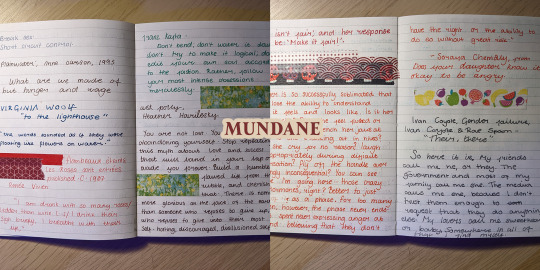
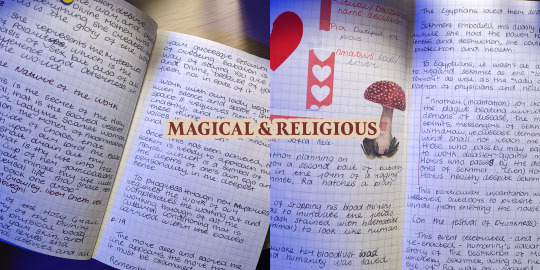
More reading on Commonplace books
https://en.wikipedia.org/wiki/Commonplace_book - The wiki page for Commonplace books that delves into their general & regional history, along with more variations on memory/infokeeping under See Also
https://notebookofghosts.com/2018/02/25/a-brief-guide-to-keeping-a-commonplace-book/ - A brief history & how-to on commonplace books, along with notable people that kept one.
https://bookriot.com/commonplace-book/ - An informal look at commonplace books, including using a tumblr blog/other digital formats as a commonplace book.
https://medium.com/thrive-global/how-and-why-to-keep-a-commonplace-book-ea80e25b63f1 - Information about commonplace books, alternatives to notebooks, and a small guide.
395 notes
·
View notes
Text
What to do with an Allan Apple?
For every Sunday leading up to Allantide I’m going to make every effort in the world to post a blog entry detailing some specific part of Cornish folk customs around the event! Today is the function of Allan Apples in divination, along with other fun divination methods!
An Allan Apple is any highly shined, big red apple. There’s no requirements beyond that! They’re easy to get hold of and their use is central to Allantide! Traditionally there were Allan Apple markets where people could go and buy their apples for the festival.
Before the discussions of apples and divination it’s important to confirm what Allantide is!
Allantide, also translated to Kalan Gwav (first day of winter), Nos Kalan Gwav (first eve of winter) or Dy’ Halan Gwav (day of the first day of winter), is analogous to Hallowe'en or Hollantide of England and Cymru, or Samhain from Éire. As a result it’s in-keeping with the themes of death, open gateways, divination and the dark of winter. More controversially (only because it divests the day and night of it’s Christian attachments) it is also a festival of magic and charms. It’s a particularly rich time for the appearance of ghosts, spirits and the Pobel Vean. Along with most Cornish festivals, fire and beacons are also very important.
Back to the apples - how to they factor into Allantide aside from the name? Divination…of course! The most important function of an Allan Apple was fortelling the users true love. They were generally given as gifts, so was a fairly easy affair. Older girls and young women would simply tuck the apple under the pillow during the night and sleep on it - that was enough to induce dreams of their future lover. Another more expansive use was to tell general fortune for the rest of winter, and even young children involved themselves in that.
Gifts of Allan Apples also brought luck to the receiver even if their divinatory use wasn’t fulfilled!
Along with the apples, young hopefuls would throw molten lead or other metals into cold water and divine their future lovers occupation from the shapes they took - a fish would be a fisherfolk, for example. There was also the tradition of couples throwing walnuts onto an open fire to ensure their fidelity to each other throughout the coming year.
In more modern times the gifting and use of all of these divination methods fell out of favour, largely in part to increased Christianisation of Cornwall. It’s starting to resurface more and more with the resurgence of folk witches and folk traditions, with apples being used as more than just divination - some offer them as gifts to ancestors passed on or as an offering to Ankow or the newly empowered Bucca Dhu.
A song has been written by a delightful Cornishwoman called Brenda Wootten and it can be found here: https://www.youtube.com/watch?v=SIGkuNyjTdM
Next Sunday’s post will be about magic and superstition in Cornwall!
crossposted to pysksos, my cornish folkcraft blog - https://pysksos.blogspot.com/2021/10/take-allan-applecornish-divination.html
50 notes
·
View notes
Text
Bucca Dhu and the Wintertide

As true with my previous post about Ankow, this contains a lot of UPG from my own personal workings and worship of the Bucca. For some interesting reading, Gemma Gary has the most easily accessible books on Them (though I personally disagree with the assigning of masculine titles & traits exclusively). I'll also note my other issue with a title assigned to Them by Gary - "Bucca Gam". I don't know the origin of 'Gam' as a title (but I'm certainly trying to find out), but it translates in kernewek to hunted game. Which doesn't seem fitting in my opinion, but as the post is going to be specifically about Dhu and Their aspects, it shouldn't come up!
I'll start with a shared view between myself and Gary's work that features a chapter entirely on the Bucca - Traditional Witchcraft: A Cornish Book of Ways.
As storms come rolling in across the land, it is said that Bucca Dhu is riding. On the dark and cold nights of winter, Bucca Dhu is also described as riding a great black horse with blazing red eyes and smoky breath. Such lore surrounding Bucca Dhu is cognate with the widespread folk traditions of the Devil and Odin/Woden, as leaders of the wild hunt, which in British tradition runs along the Abbot's Way towards Cornwall; the last stop en route to the Otherworld. (Page 79)
Bucca Dhu is the storm god associated with the winter months, the inner words, introspection, dark and defensive magic and the new moon. Bucca Dhu is seen to rule from Allantide to May's eve. Both Bucca Gwidder and Bucca Dhu however are associated traditionally with mischief and unpredictability (reminiscent rather of Cornwall's remarkable and famously changeable weather. This may be seen as something of a paradox hen considering Bucca Dhu's introspective association, however introspection can take us to the deeper animalistic parts of our being. (Page 83)
While personally I do not use Christianity or Christian parts of Cornish folk magic within my craft, and do not equate the Bucca Dhu to literally be the devil/masculine evil/witchfather (in part because I still hold spite over Methodism and Victorian sensibilities trying to 'domesticate' the Cornish - note I do celebrate some holidays that are Traditional to Cornwall that have been Christianised), there are certainly wider folkloric links between the two!
Bucca Dhu, within my practice, holds the role and titles of Androgyne Destroyer, Master of the Wintertide, Mother of Storms and Chief of Beasts (in contrast, Bucca Gwidder is the Fair Creatrix, Mistress of Summertide, Father of the Calm seas and King of the Land). I invoke Them specifically during the Wintertide to give Gwidder Their respite, and outside of that I invoke for matters of undoing, binding, emotional wellbeing and blasting (baneful magic). They are also my guide for shadow work as a matter of introspection and hold power over the solemnity of ancestor worship (Gwidder, meanwhile, is full of the joys of Spring in ancestral worship, festivals, outward workings, etc).
To list their domains outside of their weather and animal responsibilities, I also include transformation and ritual purification in the terms of inward rites, periods of liminality, home and hearth, communication, visual arts (as opposed to Gwidder, who holds more power over written arts). They also bless the Apple Trees during Wassail and guide any rites or workings preformed over the festival period comprising of Nadelik, Candlemas, Nickanan Night up to Shrovetide. They also, in my experience, are wonderful to invoke for rights that involve Annown (though Gwidder is also wonderful for this - I'd separate them by Dhu is wonderful for Annown workings that involve introspection/answer seeking and Gwidder is perfect for Annown workings that are more about reaching out and communing).
A more general writing about Bucca - in my own views and customs They are such uniquely Cornish deity. Unlike the Hellenic/Theoi Pantheon (which I also venerate) they are so much more local and concentrated down to just the county, it's an intense feeling to work with them...especially on ancestral burial lands. I've noted that They still hold some power in Devonshire lands, mostly the moors, but during a cross-country trip their absence was sorely felt all the way through until Scotland. I am going with the theory that the Bucca simply refuses to inhabit lands held by the English - Scotland is a fellow celtic nation with wild lands and old gods, so perhaps They felt more keen to be felt where Their nature is already understood. I can't speak to Their influence outside of Cornwall in the overseas sense - I don't tend to travel much in these covid times.
I do feel a great deal of affection for the Bucca, both combined and separated into Dhu and Gwidder. They are intimately involved with my life and it's a special gift to be given. I hold a physical piece imbued with Their energies, a hagstone on green thread (green, of course, for the powers of the land and physicality. It's also imbued with sprowl from multiple long walks across the sacred landscape.)
Also posted to https://pysksos.blogspot.com/2021/10/bucca-dhu-and-wintertide.html
54 notes
·
View notes
Text
Blood Percentage and Celtic Paganism
Blood Percentage and Celtic Paganism
I’m an eighth Irish and there’s some Scottish in there too, so I’m excited to be connecting with my culture and history.A Random American Pagan We’ve all met or have been this person at some point in our life. Perhaps not American, but reaching back to our roots and finding our hereditary culture in an effort to connect with the past. I’m here to explain to you why this kind of logic about roots…
View On WordPress
112 notes
·
View notes
Text
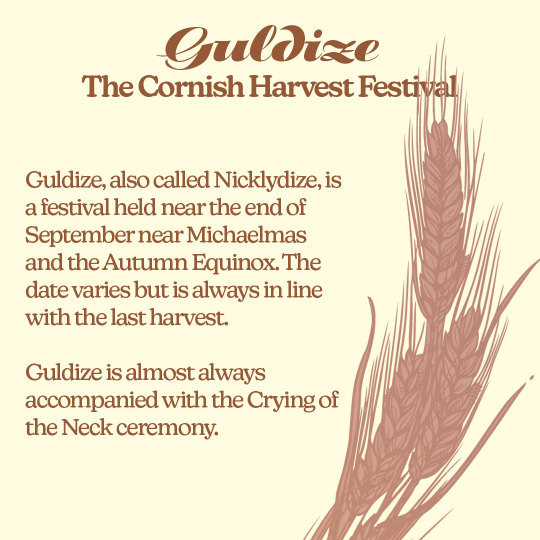
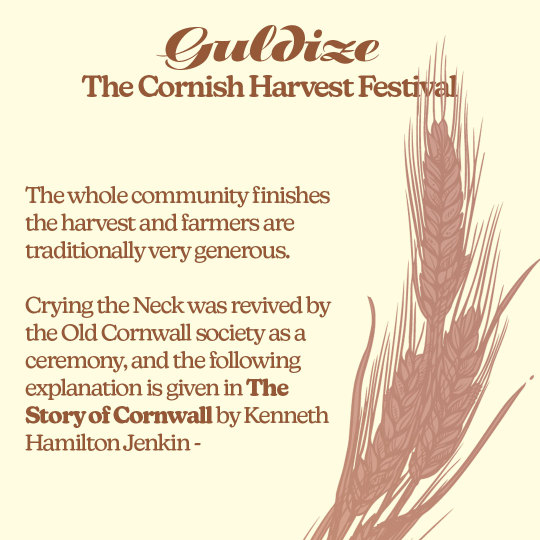
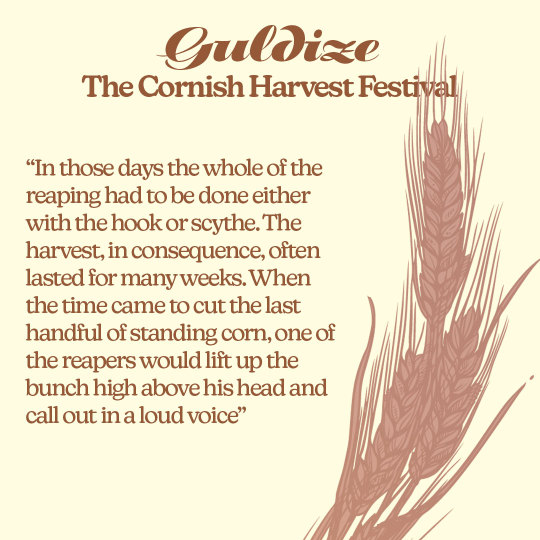
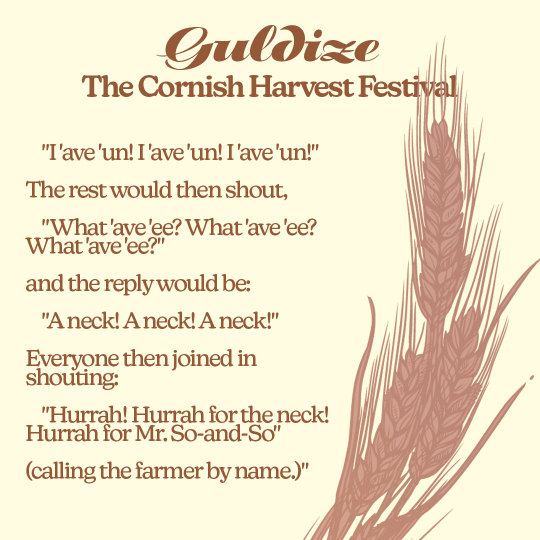
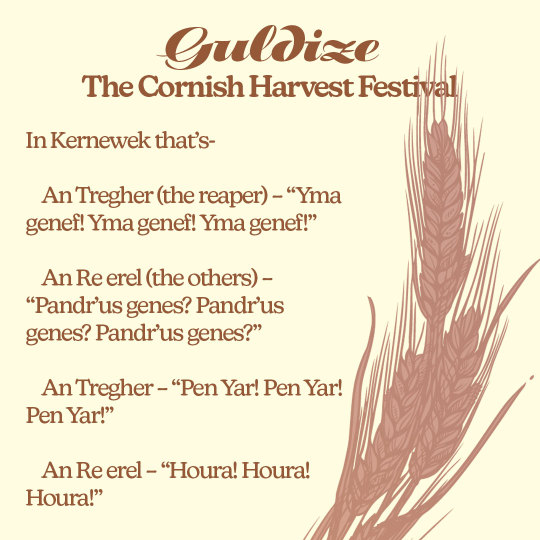
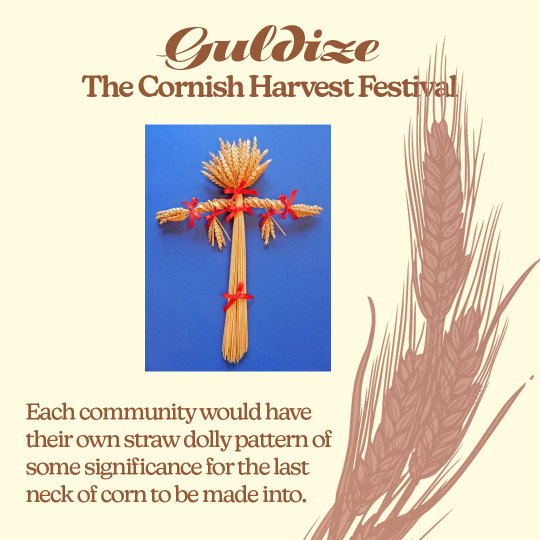
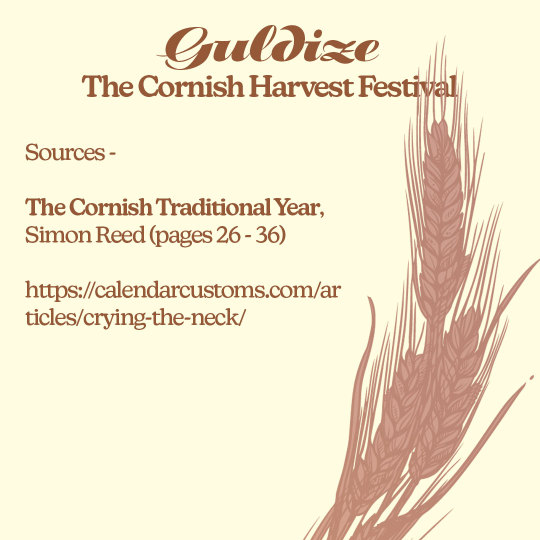
Guldize - Cornish Harvest Festival
Slide 1
Guldize, also called Nicklydize, is a festival held near the end of September near Michaelmas and the Autumn Equinox. The date varies but is always in line with the last harvest.
Guldize is almost always accompanied with the Crying of the Neck ceremony.
Slide 2
The whole community finishes the harvest and farmers are traditionally very generous.
Crying the Neck was revived by the Old Cornwall society as a ceremony, and the following explanation is given in The Story of Cornwall by Kenneth Hamilton Jenkin -
Slide 3
“In those days the whole of the reaping had to be done either with the hook or scythe. The harvest, in consequence, often lasted for many weeks. When the time came to cut the last handful of standing corn, one of the reapers would lift up the bunch high above his head and call out in a loud voice”
Slide 4
“I ‘ave 'un! I 'ave 'un! I 'ave 'un!”
The rest would then shout,
“What 'ave 'ee? What 'ave 'ee? What 'ave 'ee?”
and the reply would be:
“A neck! A neck! A neck!”
Everyone then joined in shouting:
“Hurrah! Hurrah for the neck! Hurrah for Mr. So-and-So”
(calling the farmer by name.)“
Slide 5
In Kernewek that’s-
An Tregher (the reaper) – “Yma genef! Yma genef! Yma genef!”
An Re erel (the others) – “Pandr’us genes? Pandr’us genes? Pandr’us genes?”
An Tregher – “Pen Yar! Pen Yar! Pen Yar!”
An Re erel – “Houra! Houra! Houra!”
Slide 6
Each community would have their own straw dolly pattern of some significance for the last neck of corn to be made into.
Sources
The Cornish Traditional Year, Simon Reed (pages 26 - 36)
https://calendarcustoms.com/articles/crying-the-neck/
50 notes
·
View notes
Text
Pobel Vean
Piskies (singularly a Piskey, collectively known as the Pobel Vean and also spelt: piskie, pigsy & pizkie) are a staple of Cornish folklore. Differentiated from Spriggans by their general benevolence & from Knockers with their preference for aboveground , they are mostly defined by being small, blue tricksters that love to dance. They’re most akin to Aos sí from Ireland and the Sìth in Scotland. It’d be an insult to lump them in with faeries - the two groups were said to have done battle in Somerset with the Piskies being victorious and the English faeries banished further north.
Variously described as folk from Annown, ancestor spirits, land guardians and then with the pressure of Methodism as unbaptised child spirits (though the latter has fallen out of use). Piskies are led by their queen Joan the Wad and sometimes by her partner & king of the piskies, Jack o’ the Lantern*.
While piskies are neighbours with the Devonshire pixie, they don’t stray any further than the Tamar river in the north - tied to the burial mounts, stone circles, menhirs & quoits littered throughout the county. Described as anywhere between palm-sized to knee height, they’re blue skinned with pointed ears and cheeky faces. Pre-Victorian folklore tells of ragged hand-made clothes or just nakedness, later replaced with green clothes and pointed caps (though again, this hasn’t stuck around much aside from tourist trinkets).
The piskies are mostly a benevolent lot - singing and dancing in great numbers on the moors and sometimes helping humans with little tasks about the home. To have happy piskies around is good luck - indeed there’s still the strong practice of carrying a little pewter piskey charm around to draw luck and money.
Piskies can also offer gifts to larger folk - helping with grain harvest or hiding sweet and delicious foods around the house. Unlike faerie foods, piskies foods can be eaten with no danger of becoming trapped.
Despite their generally good nature, there are still stories of travellers becoming piskey-laden on the moorland and in quiet country paths. The most accessible one was taken down by Enys Tregarthen - How Jan Brewer was Piskey-Laden. The only way to avoid coming piskey-laden (or to escape it) is either turning all clothes inside out, or all pockets inside out. Often those who are piskey-laden have stumbled across a dance and the piskies, preferring their celebrations to be secret and disliking spies, confuse and maze someone until they are lost.
Some more malicious piskey tales tell of them leading travellers astray on Bodmin Moor by appearing like a lantern in a cottage window, loosing a farmer’s horses and cows, or causing general misfortune and naughtiness. In folktales, these naughtier piskies meet their match with a quick witted and competent traveller charming them back and escaping any chance of being laden.
Good practice when visiting a stone circle or other favoured piskey home is to bring a little milk and bread (or scone, split or hot bun) and leave it about as a gift. They also enjoy gifts of fabric and ribbons to incorporate into their outfits!
*A note - Wad is an Eastern Cornish colloquialism for a bundle of straw used as a torch, tying Joan and Jack both to fire. Joan is also associated with water & good luck.
45 notes
·
View notes
Text
unrecorded cornish deities lets go lets go
(hint its almost all of the ones I've encountered!)
8 notes
·
View notes
Text
A selection of Cornish Folklore books & pamphlets
Lodenek Press
Fairies forever - Corneau, Marie-Helene Arthur’s Cornish legend: secrets of the holy grail revealed - Corneau, Marie Helene; Corneau, Jean Cornish Sayings, Superstitions and Remedies - Hawke, Kathleen Traditional Cornish Stories and Rhymes - Rawe, Donald R. Haunted landscapes: Cornish and Westcountry tales of the supernatural - Rawe, Donald R.
Oakmagic Publications
Signs, omens and charms: a Cornish clergyman’s guide to the superstitious - Anon Hawker’s tales of ghosts & witchcraft - Hawker, R. S: Cornish giants - Bottrell, William; Jones, Kelvin I The little book of ancient charms - Dyer, T. Thiselton The Cornish folklore handbook - Kinsman, John Customs & superstitions of East Cornwall - Couch, Jonathan; Couch, Thomas Weird Cornish tales: three stories of the supernatural - Jones, Kelvin I Folklore & witchcraft of Devon & Cornwall - Jones, Kelvin I Cornwall’s wonderland - Quiller-Couch, Mabel The popular mythology of Cornwall. Vol.1, Faeries - Jones, Kelvin I: The Cornish Cross: its Pagan origins - Courtney, R. A. (Richard Acutt) Seven Cornish witches - Jones, Kelvin I Arthur’s lost land: the legend sites of North Cornwall - Walters, Jack Cuming Cornwall’s ancient stones: a megalithic enquiry - Dymond, C. W Folklore in the Cornish language - Nance, R. Morton (Robert Morton) Bizarre Cornish beliefs - Penn, Peter Cornish folklore collection: witchcraft, spells, charms, cures & superstitions (volume one) - Jones, Kelvin I; Kent, Alan M. associate series editor Superstitious Cornwall - Jones, Kelvin I; The Cornish Magazine and Devon Miscellany; The West of England Magazine Cornish Year: Cornish Folklore, Festivals and Characters Throughout the Year - Clinnick, A.A The popular mythology of Cornwall. vol 3, Giants and ghosts - Jones, Kelvin I Cornwall’s pagan heritage - Courtney, Richard Acutt Anne Jefferies and the fairies: and other Cornish fairy tales - Jones, Kelvin I Padstow’s faery folk: and other faery tales of North Cornwall - Tregarthen, Enys:
Tor Mark Press
Cornwall’s haunted houses - Caine, Margaret; Gorton, Alan Piskies, Spriggans, Knockers and the Small People: Traditional Tales From Cornwall - Anon Classic Cornish ghost stories - White, Paul Cornish Charms & Witchcraft - Anon
38 notes
·
View notes
Text
Colour Magic in Cornish Folk Craft
A mix of UPG & Correspondences from Gemma Gary's Traditional Witchcraft: A Cornish book of Ways
🟥 Red magic is based in the land's energy. The serpent and sprowl dominate this, and imbue it with potency and empowerment when used in magic. This colour is also used in workings of a sexual nature as well as protective forces. It is best tapped into for far-reaching spells and the use of poppets. It is sustaining and firm. It's corresponding animal is the serpent. The Grand Bucca has rights over this colour
🟩 Green magic is physicality and the land itself. It's given power by flora and growing things, as well as the fauna that needs it for survival and are animated by the sprowl running through it. It is ideal for craft involving healing, herb and kitchen craft and material gain. It is ideal for homeworkings and hearth worship. It is generative and expanding. It's corresponding animal is the Hare. Bucca Gwidder has rights over this colour.
⬛ Black magic is the magic of the unseen, of Annown and hidden guests. It also corresponds to darker and more baneful forces. Craft involving ancestors, spirits, divination and influence and especially deep emotions and behaviour are all enhanced under this colour. It is also associated with dreams and sleep, baneful hexes and blasting. It is favoured for outdoor rites and night workings. It is consumptive and shrinking. It's corresponding animals are the crow and the Black Toad. Bucca Dhu has rights over this colour.
29 notes
·
View notes
Text
The Bucca, an unverified overview, pt 1
A lot is based on my own personal experience and workings, as well as experiences as a cornishperson. Some parts are also mentioned in Gemma Gary’s writings - I will try to link pages/passages into my own writing! Assume from here on out, all writings are UPG. Further parts will be edited with a link! I am also happy to answer specific questions :-)
The Bucca, also called the Grand Bucca or simply ‘Bucca’, is a Cornish deity with very little written record of Their existence. They represent the constant change that takes place in Cornwall - the tides, weather, seasons, harvest, life, death & renewal. They also take the role of the trickster in more recent times - teasing the overly-serious, overly-rigid structures in place in Modern Cornwall.
Made of two halves (Bucca Dhu and Bucca Gwidder), the Bucca is a androgyne deity - encompassing all genders and transcending them in equal measure, referred to by myself as They/Them in english and hynn/ho in kernewek. They straddle and freely ride the line between deity and pobel vean - a folk deity confined to the Cornish landscape with far reaching influence on weather and fish. They freely move between Annown, here and Nevek, encompassing the threefold track.
21 notes
·
View notes
Text
Jinny* so Far
*secret horse deity currently named Jinny as in Cousin Jinny.
Based off intuition, card readings, research with regards to horse deities (pan Celtic figure) and offerings at Bosiliack Barrow. Horses in general were also important pan-Celtic animals!
General realms seem to include fertility, rites of passage (both in the normal sense and the Actual Sense of They’re needed for passage). A running thread through here, Annown and Nevek. She doesn’t feel as tied to land-fertility as the Bucca, but perhaps more about agriculture/farming/food gathering?
She feels like a neolithic/ancient deity, Her visage alternating between the below “wild woman” and a basal horse like Przewalski’s horse.
The results of a small intention-setting meditation-type-thing:
I’m pretty sure I managed to visualise/meet Her in a similar way I met the Bucca in the first Meditation Monday (Mosswood event) - a kind of stereotypical “wild woman” with a horse skin cloak that shied away from close contact (whereas with the Bucca I could touch/be touched in a far more intimate/ friendly way). I offered Her fresh tea from a kettle over a fire as an offering in Annown and I’m a bit sad She’s been forgotten/unrecorded since the vibes are deeply rooted™️.
5 notes
·
View notes
Text

"Lucky Summer" Wild Garlic/Ramsons Pesto
Following this general recipe - https://www.bbcgoodfood.com/recipes/wild-pesto (with some additions/changes for my diet.) These are my personal correspondences
Wild Garlic/Ramsons: Abundance, productivity in the realms of spreading (reproduction, influence, friendships/relationships, etc.)
Garlic clove: Protection against unhelpful "drains" (anything that will drain me and provide no benefit to me - e.g, wearing myself out with work and having no good result at the end), home and hearth happiness
Sunflower seeds: confidence and summer contentment
Olive Oil: Peacefulness, richness of experiences.
Nooch/Nutritional Yeast (replaces cheese): 'All of the good without the bad', enjoy the luck this brings without suffering ill consequence.
Lime: Strengthens it all, adds a kick of ~ zest ~
Blend together and enjoy with anything you'd enjoy regular pesto with! I especially like using it at the start of summer when ramsons are in full swing to help make my summer season especially productive and good.
24 notes
·
View notes
Note
What are some Cornish celtic deities and if you can find it what are some good resources for them
I'm not a cornish/celtic pagan, but @wolverinewitch may have something to say about it!
61 notes
·
View notes
Text
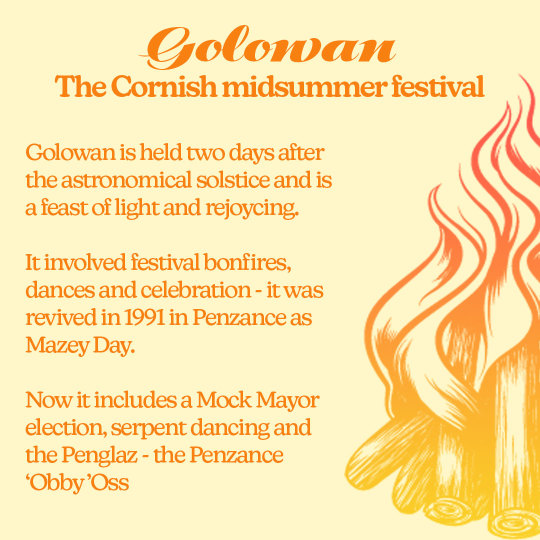

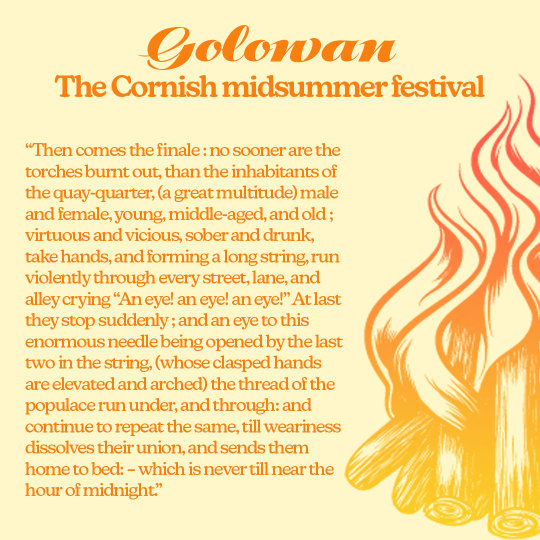
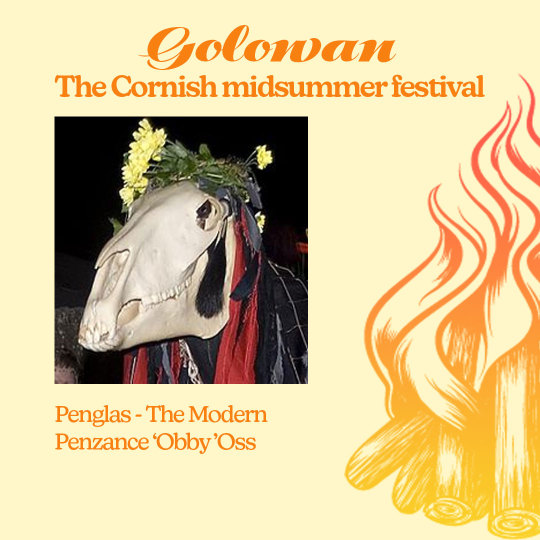
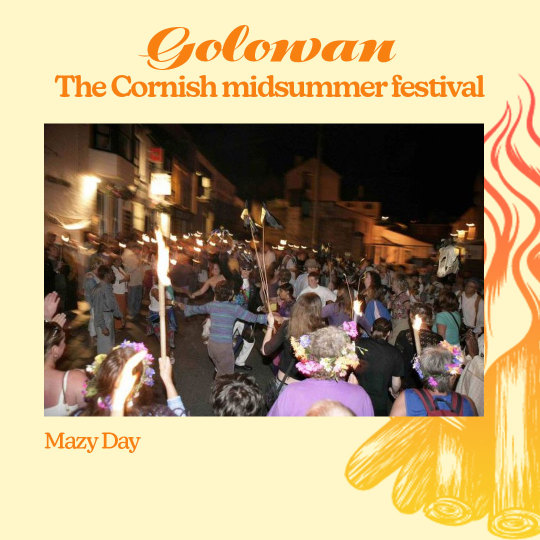

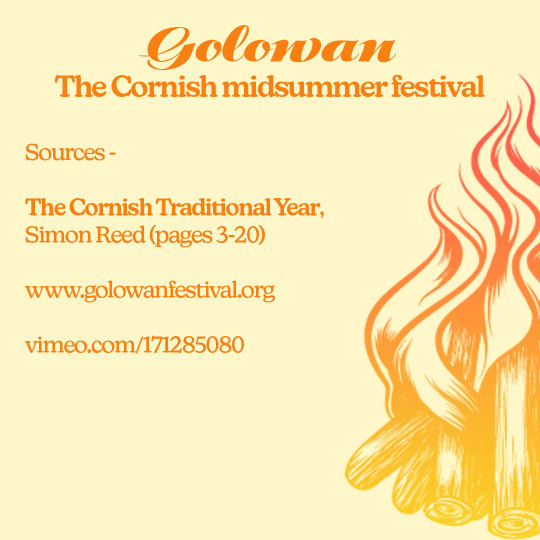
GOLOWAN: The Cornish Midsummer Festival
SLIDE 1 -
Golowan is held two days after the astronomical solstice and is a feast of light and rejoicing.
It involved festival bonfires, dances and celebration - it was revived in 1991 in Penzance as Mazey Day.
Now it includes a Mock Mayor election, serpent dancing and the Penglaz - the Penzance ‘Obby ’Oss
SLIDE 2 -
Historically, Golowan included dancing around and through bonfires to protect from evil intentions. It was also very lucky to scatter hemp seeds for love!
Children would wear wreaths of St. Johns wort too.
The Serpent Dance is a fixture of Golowan and Mazey day! It’s a chain of people dancing through the streets, described by ‘T.J.R” as
SLIDE 3 -
“Then comes the finale : no sooner are the torches burnt out, than the inhabitants of the quay-quarter, (a great multitude) male and female, young, middle-aged, and old ; virtuous and vicious, sober and drunk, take hands, and forming a long string, run violently through every street, lane, and alley crying “An eye! an eye! an eye!” At last they stop suddenly ; and an eye to this enormous needle being opened by the last two in the string, (whose clasped hands are elevated and arched) the thread of the populace run under, and through: and continue to repeat the same, till weariness dissolves their union, and sends them home to bed: – which is never till near the hour of midnight.”
SLIDE 4 -
Golowan is in part a feast for St. John, however it’s pagan roots may go deeper.
The serpent is an aspect of Cornish folkcraft and is the familiar spirit of red magic.
Mazed (used in Mazey Day) carries the definition of being intoxicated, entranced or in a maddened state of being.
Slide 5-
Sources:
The Cornish Traditional Year, Simon Reed (pages 3-20)
www.golowanfestival.org
vimeo.com/171285080 Posting earlier than Golowan because I’m off to Boscastle for the day instead of being online! If anyone has other sources, book recs or anything similar about Cornish folk witchcraft, traditional holidays, etc - please send me them!! I’m trying to build a mini library I can share :-) It’s hard to find resources online and I want to try fix that.
20 notes
·
View notes
Text
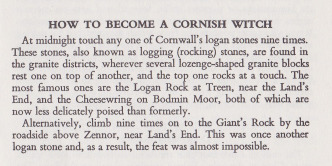
New rite for fellow cornish witches just dropped B)
2 notes
·
View notes
Text

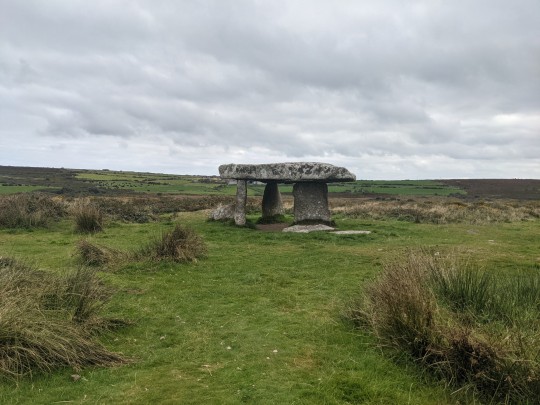
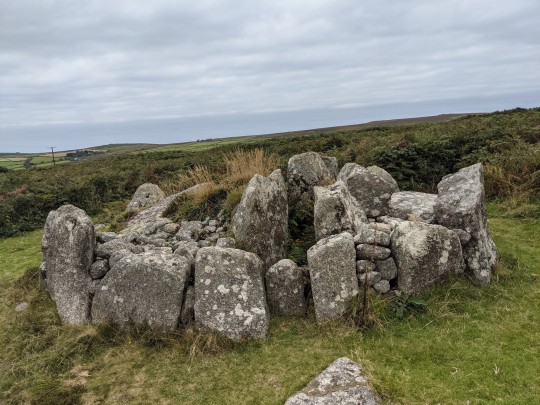
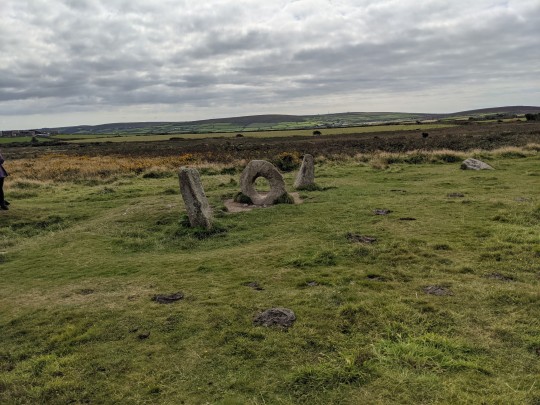
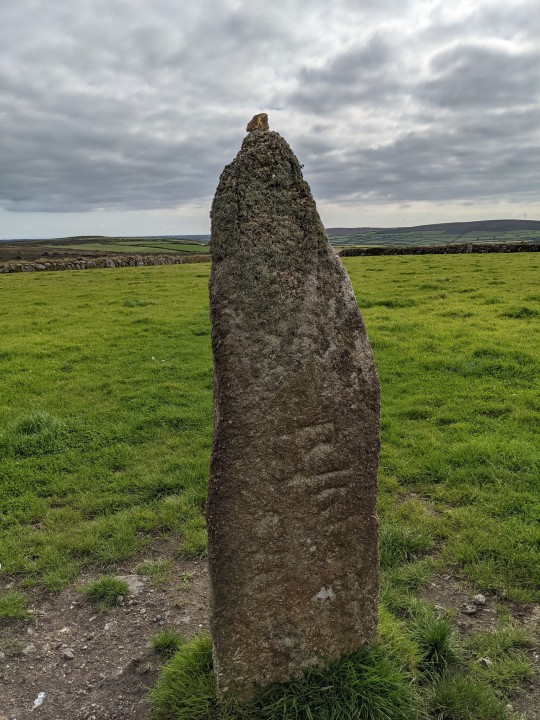
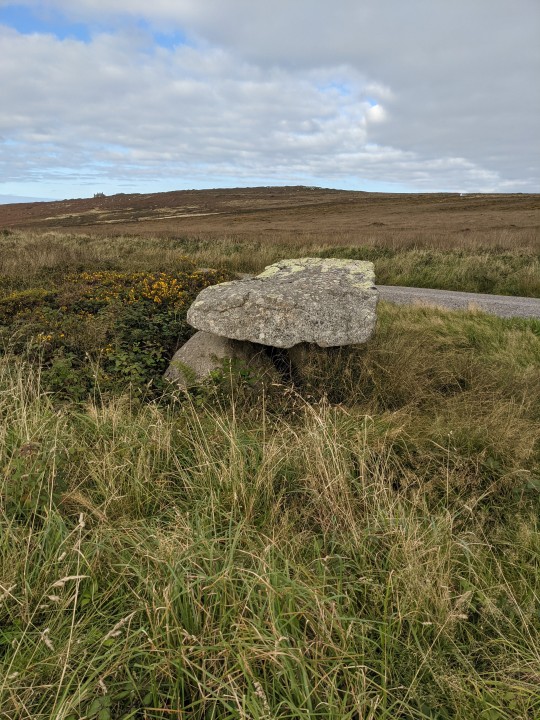
In celebration of the equinox and to give offerings to my land-ancestors, a friend and I went on a hike across Penwith. We picked our places in advance and tried to stick to them with minimal wandering - it’s rough terrain with plenty of mine shafts to disappear into.
In order we tried to get to - Madron Holy Well, Lanyon Quoit, Lanyon Tea Room (we needed refreshments!), Bosilack Barrow, the Men-an-Tol, Mên Scryfa and the Venton Bebibell holy well, before hiking over to Morvah to get the bus back home. I took a baked lavender loaf along to leave a bit in each place as an offering to ancestors and the land.
5:30am start for me - thankfully I slept well enough that I didn’t crash immediately. Breakfast and out into a misty street which felt especially appropriate for the day. Our travel before we actually start the hike took two hours via bus, but it was nice to sit back and watch rolling Cornish fields go by!
Once we got off in Madron we started the walk - the footpaths are well worn into the ground and none of them were paved (aside from loose rocks…but that doesn’t quite count). It was fairly easy between the bus stop and the Chapel, it was still a bit of a trek across fields and a very humid trail to the chapel. I threw the first off the loaf deep into the flora, letting the Piskies know it’s all theirs as a gift. We found the chapel and sat with a snack and a drink, and enjoyed the incredible peace that we found there. There was a very funny bird call - sounding like a whistle for our attention. In retrospect it was likely a blackbird! What a wonderful thing to hear during a day of transition - from the last of summer into true Autumn, AND a day full of magical occurrences. We headed back along the trail but unfortunately we could only hear the well, we couldn’t get to it because of an awful lot of mud and brambles (my legs look like they did as a child on adventures)! My friend and I tied up some cotton muslin (biodegradable - it’d be disrespectful to leave something polluting there) and made our wishes.
After trying (and failing) to get closer to the Holy Well, we decided to stop squelching about in the mud and head up and out towards Lanyon Quoit. We trekked up a very buzzy right of way, I squealed about a Cornish Cross in the verge, got slightly turned around in a field full of cows (and I lost a button getting over the wall), and ended up with wet feet before we finally got to the Quoit. It had a very “homey” atmosphere - like walking into a close relatives house while they’ve got a party with all the familiar ancestors. We elected to eat the majority of our lunch there under the quoit, sharing bread and coffee with the ancestral spirits and chatting quite openly between both ourselves and any unseen hosts.
Back across the stile and off down to Lanyon Tea Room to get a coffee and a sit down (and use a toilet!). The most beautiful little spot in the middle of nowhere and well worth a visit if anyone visits the area. All along our hike we saw birds of prey - beautifully circling and hunting. They were the most wonderful and direct signal from Annown that ancestors and spirits were watching and guiding us today. After our little coffee stop we doubled back up the path to Bosiliack Barrow.
It was a rougher hike to it and we didn’t realise how close we were until we were on it. It was a much more sombre and unsettled energy, a tomb forgotten and crying and lost in a landscape that became unfamiliar to the ancestors there. The barrow is a neolithic tomb with a Scillonian entrance - it aligns with the rising winter solstice sun. I sat with my back against the stones, letting the energy settle and it truly felt like someone resting their hand over mine. I left a large chunk of the bread and burning incense there, and have made a promise to myself and them to include space on my altar for the unsettled ancestors to seek peace.
There was a mild case of getting piskey-laden while trying to make our way to the Mên-an-Tol - every gate was like the wrong gate until pockets were turned inside out and a very firm “please stop!” was yelled into the land. It was still a struggle after that though for different reasons - the path was incredibly overgrown with brambles and thistles and all kinds of grasses and I came out very cut up and my friend had a panic with how close and bug-y everything was. It didn’t last long - only five or ten minutes - and then we were on a much more established path that runs from Ding Dong mine through to the Mên-an-Tol. We went past more than a few caved in mine tunnels - the whole land beneath us like swiss cheese.
Once we got to the Mên-an-Tol we took it in turns to wriggle through the holey stone, now neither of us will get rickets, and admire the landscape around us. We also took a moment to have a few snacks and drink some water, coming up the last of our hike stops before we headed down to Morvah. The Mên-an- Tol still has ancestral energy but it’s vastly different - Lanyon Quoit and Bosiliack Barrow were homes and tombs, but the Mên-an-Tol is a ritual site! A place of ceremony and celebration! It was relaxed and welcoming. Quite a few people had left gifts of their own there, so it’s nice to know our own gifts are in good company.
After the Mên-an-Tol we walked up the incredibly easy track to Mên Scryfa - a carved standing stone. I left bread on the very top of it as a gift to the ancestor it marks - Mên Scryfa translates to “Stone with Writing” and commemorates Rialobranus son of Cunovalus (Wikipedia and other sites go into much more detail about it). It was a very open energy - Madron Chapel & Bosiliack Barrow were both closed, intense energies while Lanyon Quoit, the Mên-an-Tol & Mên Scryfa have open inviting and relaxed energies (along with the rest of the land’s sprowl). It was wonderful to see it. Afterwards we tried to find the Venton Bebibell holy well but unfortunately while we heard and just saw the bottom, it was incredibly overgrown and unsafe for us to get too close too (not for lack of trying)!
After hiking down to Morvah, bothering the most beautiful cows and waiting for the bus back, google maps totalled our walk to 8.3 miles (I’m not sure if that includes going up hill & down dale though). Tiring, rewarding, a chance to reenergise with sprowl and imbue my wiggly ritual knife with the serpents energy. I’ve already started planning a trip back to the barrow on the winter solstice to pay respects and care for the ancestral soul there, next time I won’t get my socks wet in the first few minutes though!
Also posted on pysksos - https://pysksos.blogspot.com/2021/09/autumnal-equinox-hike.html
36 notes
·
View notes